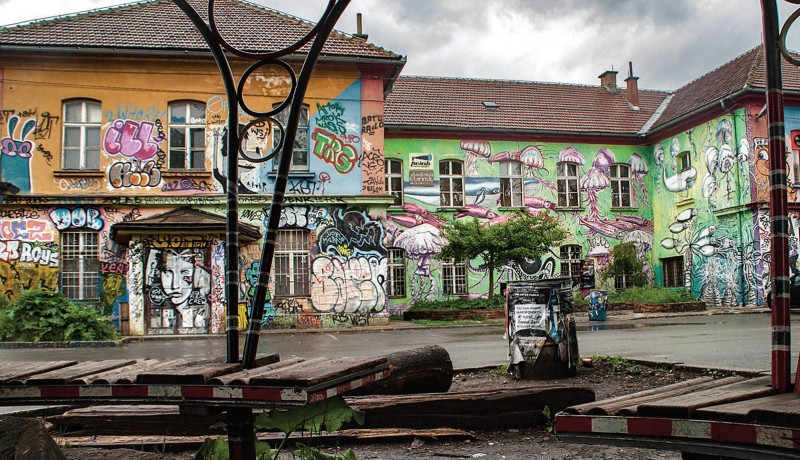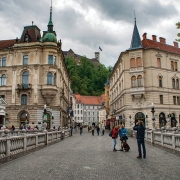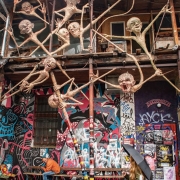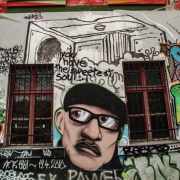
Etcetera

From serene lakes to medieval structures and unique art spaces like the spirited Metelkova district, Slovenia’s capital Ljubljana packs it all
As I entered Metelkova, the world suddenly changed into what I would call an artist’s playground. Streets to buildings and eveything else in between was painted in red, blue and white, with some graffiti art depicting a sad yesterday, and some, a promising tomorrow. A broken bike frame, a rustic car model, a giant toe… each piece of art was telling a unique story.
The Metelkova district in Ljubljana, which depicted a sad and oppressive space back in time, has today built its image firmly on its artistic and culturally liberal credentials. An oppressive territory and a stronghold of the army of the authoritarian Socialist Federal Republic of Yugoslavia during the Austro-Hungarian Empire in the late 19th century, Metelkova has come a long way.
This secret transformation has given Ljubljana yet another reason to be in the spotlight, besides other tourist attractions such as the Dragon Bridge—with dragon statues in all four corners of the bridge—and the sprawling Tivoli City Park. Travel companies sell their packages highlighting Metelkova as a ‘must travel’ destination while savvy travellers plan a quick stroll by themselves, savouring their senses and experiencing the rich artistic community spirit in the air. Much like the art-centric streets of Berlin and the colorful Sao Paulo, Metelkova integrates the voice of local residents and artists into its fabric of narratives. A walk around the walled city reveals beautiful cafés and bars, elegantly fading old colonial buildings, and a lot more about Ljubljana’s centuries-old history.
The story of Metelkova’s transformation, however, isn’t as simple as it may seem. When Slovenia gained independence in 1991, and the army barracks in Metelkova were destroyed, many activists and local artists petitioned the government to use the site creatively, instead of turning it into a commercial property. When that didn’t work out, citizens took things into their hands and forcefully declared it an autonomous zone. Now, every year, Metelkova hosts over 1,500 events inside its occupied premises, catering to a wide spectrum of cultures and ideas. Literature evenings, theatre performances and jazz concerts showcase Ljubljana’s and Slovenia’s willingness to accept global ideas.
Known as Metelkova Mesto or Metelkova Artistic Space, it is one of the largest and most successful urban squats in Europe, a leading centre of underground music and art. Many people visit it daily, with some, like me, being in Ljubljana for Metelkova, and Metelkova alone.
Recommended by someone I met in Croatia, Metelkova truly turned out to be how it was defined: ‘The most impressive graffiti areas one can see in one’s lifetime.’ But owing to its autonomous nature, the 12,500-sq-m area also has a frightening feel to it, at least during the daytime. Army impressions loom large, and it is hard to believe that it’s a free territory now. The streets, moreover, may look empty and paranoid. But once night settles in, it becomes the focal point of the country’s alternative culture scene, as dozens of tourists pour in to find their own way of entertainment.
I reached Metelkova around noon, and was pretty excited just walking through the entrance—it’s like a walled city sitting in a central Ljubljana neighbourhood. As I entered through one of the side entrances, I saw a bunch of tourists taking a walking tour, even as locals were fixing up ramps and shovelling dirt. Giving them a friendly nod, I tried to look as hip as possible as I walked past.
One of the reasons that makes Metelkova a popular destination among tourists is the selling of cannabis—mostly hashish—on its streets. But there’s much more to Metelkova than open selling of drugs and a severe disregard for law. It has clubs, bars, galleries and art studios galore. It’s indeed a place where ideas run free. The many events and concerts, disability workshops and LGBT clubs show the open-mindedness of the locals.
Going beyond Metelkova, Ljubljana is also a definite paradise for nature lovers, with less than 300,000 inhabitants and more green spaces than houses. For instance, Tivoli Park, designed by French engineer Jean Blanchard in 1813, is popular for its walking trails, floral arrangements, fountains and sculptures. Among sculptures, the highlight is Coexistence, a work of art designed from a 300 year-old oak tree that fell in a storm.
An hour’s drive from Ljubljana is Lake Bled, the only natural island in Slovenia. It’s so dramatic and unreal that it reminded me of the Disney movies I grew up watching. Speaking of the unrealistic beauty, picture this: A fairytale medieval castle with a Roman style tower overlooking a serene lake, which sometimes appears green, and some times blue. Almost in the middle floats a small island, home to a church and a couple of al fresco cafés creating an enjoyable ambience. The lake is moreover so calm and undisturbed that the only movement one can sense is the flap of a duck wing or the dip of a kayak paddle.
A quick visit thereafter to the Postojna cave, quite unlike the few caves I have walked, swam and even paddled a canoe through, took my breath away. After all, Postojna is Europe’s largest cave park and a UNESCO heritage site. With its 21 km of passages, galleries and magnificent halls, it offers a unique experience of the underground world. The guided tour, which is offered in 15 different languages, takes about an hour-and-a-half to finish, with two, 20-minute train rides inside the cave and a half-an-hour walk. In 1899, the world’s first underground postal office was operated in the cave. Today, Postojna is Slovenia’s biggest tourist attraction that has welcomed over 37 million people so far…and still counting!
One may not need more than three days to get a good hang of Ljubljana, as the town is pretty tiny and accessible by foot. A vibrant outdoor eating and drinking culture adds to the charm of the place. Speaking of local food, I recommend the Cevapcici sausage, served with sliced onions and fresh bread, and Štruklji, a sweet-and-salty baked bread dough, filled with cottage cheese and herbs, and rolled into a roulade.
Indeed, given the green lungs in the district, it’s not hard to see why Ljubljana was awarded the Green Capital of Europe title in 2016. From serene lakes to medieval structures and spirited art spaces, Ljubljana packs it all.
FACTFILE
WHEN TO GO
Though it’s fairly okay to travel to Ljubljana at any time of the year, you may want to avoid winters owing to the freezing temperatures. The weather is warm and sunny between March and September.
VISA AND CURRENCY REQUIREMENT
As Slovenia is a part of the EU and shares the common currency, getting some Euros can never be a problem. If you’re visiting Slovenia and other countries in Europe, it is best to carry a travel card issued by your bank. Using travel cards to deal with major currencies abroad is always convenient and hassle-free. For Indian nationals, it’s mandatory to apply for the Schengen visa. The validity of the visa can be up to a period of three months.
TIPS
If you’re staying in Ljubljana for a few days, it is advised to explore Predjama castle as well. A half-day tour can be booked from Ljubljana.
Text & Photos: Devesh Joshi Featured in Harmony — Celebrate Age Magazine September 2017
you may also like to read
-
Cracking the longevity code
Small yet impactful choices can be game-changers, writes Srirekha Pillai At 102, there’s no stopping Chandigarh-based Man Kaur, the world’s….
-
Home, not alone
While a regulatory framework is vital for senior-care facilities, the need of the hour is to develop an ecosystem to….
-
Birthday Girl
Published in a special edition to honour Japanese master storyteller Haruki Murakami’s 70th birthday, Birthday Girl (Penguin; Rs 100; 42….
-
A huge treat for music lovers
Published as the revised and updated second edition, Incomparable Sachin Dev Burman (Blue Pencil; Rs. 599; 470 pages) the authoritative….










